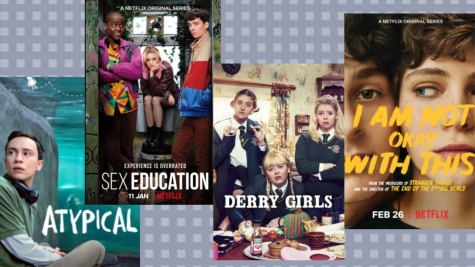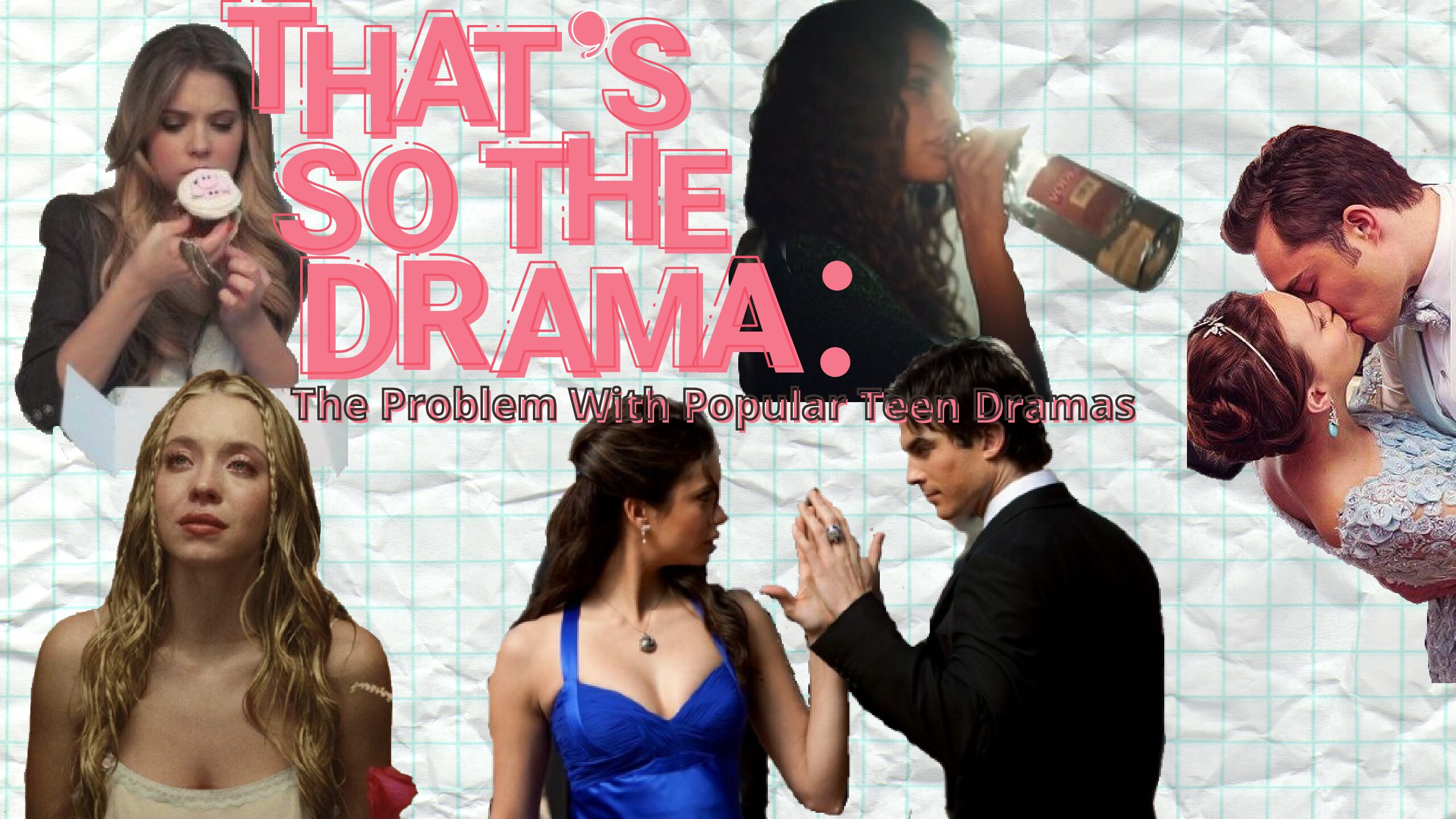That’s So the Drama: The Problem With Popular Teen Dramas
Trigger warning for discussions of eating disorders, fatphobia, underage drug and alcohol use/addiction/abuse, violence, and abusive/toxic relationship traits.
June 1, 2022
The newest generation of teens and young adults, known as “Gen Z,” arguably had the best television dramas growing up; as time goes on, these dramas have matured well and have proven to be relatable to many audience members. Currently, airing television shows like HBO’s Euphoria have garnered enormous fan bases on social media platforms such as TikTok and Instagram. Even Euphoria’s social media fan pages have over 6 million followers, most of whom are teenagers.
While casting older actors is convenient for the working process, a young adult actor does not look like a 17-year-old. Cast members being significantly older than their characters can lead to unrealistic beauty standards for what teens should look like. Barbara Greenburg, a clinical psychologist, said, “their portrayals can give the message that teenagers are supposed to look good all the time.”
Greenburg continues the idea casting adults to play teens sets unrealistic beauty standards, and said “some days they’re a little heavier, they have pimples, their hair is a little frizzy. It’s all okay.”
In more recent years, movies and television shows have allowed for a more realistic portrayal of teens. During the production of the film Lady Bird (2017), actress Saoirse Ronon had an acne breakout, and the makeup artist asked if she would be okay with letting the acne show rather than covering it up, and Ronan agreed. Later, Ronan said, “I thought it was a really good opportunity to let a teenager’s face in a movie actually look like a teenager’s face in real life.”
The film’s director Greta Gerwig also said, “All I see in movies about teenage girls is they have perfect skin and perfect hair, and the reality of teenagers is they don’t! And it doesn’t make them less beautiful.”
Eating Disorders
In media, there are multiple examples of symbolic annihilation mostly caused by a severe lack of body diversity or representation. Symbolic annihilation is defined as the absence of representation, or underrepresentation, of some group of people in the media (often based on their race, sex, sexual orientation, socio-economic status, etc.), understood in the social sciences to be a means of maintaining social inequality.
The lack of body positivity within media has major underlying effects on viewers, making them feel like they are required to have standard slim, fit figures. The only character with a diverse body type is the “fat best friend” archetype, whose entire character arc is typically hating themselves for being overweight.
In teen dramas, the majority of the characters are thin; if they do not fit the media’s idea of a “perfect body,” the character’s whole arc becomes surrounded by just that idea. Pretty Little Liars, Hanna Marin is the chubby friend nicknamed “Hefty Hanna.” When she is anxious, she binge eats, leading her to become a joke about anything related to food. Desperately wanting to be skinny, Hanna undergoes a serious summer makeover.
She later states that she only ate “one almond a day,” and even after losing a significant amount of weight, she is still insecure about her body. Watching shows that feature characters with one body type, who make jokes about food, and create an unhealthy environment for those struggling with their outward appearance sends a negative message to viewers who do not match the “perfect” body type as seen on TV.
Madi Williams a journalist for the Tacoma Ledger says “While I don’t believe [and am not] trying to say that eating disorders are caused directly by teen drama shows, I am trying to draw the connection between popular shows that teens continuously watch and how the characters within them deal with the weight of themselves and others. Recognizing the sort of media that influences teens could be a productive way to begin to better understand and combat the issue of disordered eating and begin to develop healthy relationships with food and our bodies from a young age.”
William’s article covers all the problems she saw while rewatching old television shows she watched as a teen and the issues she only saw as an adult. The messages, while going over her head at the time, were still being absorbed into her beliefs and behaviors.
Furthermore, Williams continued on to outline the hurtful ways young teens have become influenced by these glorified eating disorders in the media. Television aimed at teen audiences often manages to simultaneously feed impressionable viewers and magnify common misconceptions such as that eating disorders can only happen to the type of people who are idolized and typified to be the same body type as those with the “ideal” feminine physique by brushing over the psychological toll taken on by those with eating disorders.
Television networks and production companies fail to expose the reality of eating disorders and neglect all other forms of it by solely painting a one-dimensional portrayal of those who suffer from it. Upon researching and trying to find a film or a show about a male with an eating disorder, none are found. There was not a single male character that has ever been televised with an eating disorder. Multiple male actors have even opened up about their experiences having an eating disorder, and South Carolina’s Department of Mental Health revealed recently that an estimated 5 to 15 percent of people with anorexia or bulimia are male, and even though these numbers may seem minimal, it doesn’t mean that they should be ignored.
Eating disorders come in many forms, affecting all genders, body types, and ethnicities. The media only portrays idealized versions of eating disorders like bulimia and anorexia, yet there are no depictions of characters who suffer from binge-eating disorders. In reality, the majority of people suffering from an eating disorder are often skinny and idealized weight rather than what is seen as “overweight.”
Although films and television like Pretty Little Liars do reveal part of the psychological and physical debilitation of eating disorders, they perpetuate the idea that with an eating disorder, one can still become beautiful and thin as a result of it. The topic is usually brushed past and does not properly illustrate the emotional toll and healing process, but instead, it is glamorized, undermining the severity of the disorder for those who suffer from the disease in real life.
Eating disorders have recently become a “trend” or an “accessory” among popular beloved characters within the entertainment industry, which does these disorders a huge injustice by undercutting their impact. These depictions are also very non-inclusive, only showing idealized parts of the disorders. This makes viewers think they do not have an eating disorder because they don’t look or act like who they see on TV and therefore leads to them not getting the help they need. These eating disorders are not something to be taken lightly, although their portrayal in the media has been grossly misrepresented.
Underage Alcohol and Drug Abuse/Addiction
The reality of drug use and addiction is rarely fully understood by young society; the media is a big factor to blame for that circumstance. A writer from the PLD Lamplighter said in their article that “[it’s] important to educate teens on the differences between the reality of substance abuse and the media’s portrayal of it. Popular media rarely depicts the repercussions of substance abuse, including the negative effects it has on an individual’s health and the increased risk of accidents that occur under the influence.”
The media’s portrayal avoids the real consequences of addiction like emotional distance from those you love and severe mental illness. According to a journalist from the American Addiction Center, the serious effects are often minimized or ignored, “leav[ing] viewers with a skewed vision of the roles these substances play in reality.”
Teenage minds are influenced by their surroundings, and pop culture plays an important role in their early life influence. A journalist from Northpoint, Washington said that “studies show that pop culture and media have a remarkably negative impact on children and teenagers, as well as young adults. It’s estimated that more than half of all high school students try illicit drugs, while more than 70% drink alcohol by the time they graduate. Of those, the youth that struggles with addiction at an early age often begin experimenting with drugs and alcohol by the age of 12 or 13.”
The impact of TV shows that include drugs and pop culture on the youth simply cannot be portrayed correctly. In the end, every person is different and every person’s experience struggling with addiction and recovery is different.
Toxic Relationships
In television, most viewers tend to go for the “bad boy” or the brooding, dark character that obviously has a lot of issues, but his awful character traits are always overlooked by his good looks and sarcastic attitude, catching viewers’ hearts.
This applies to most love interests that viewers root for. Some examples include Chuck Bass in Gossip Girl or Damon Salvatore in The Vampire Diaries. Some traits that characters such as Chuck and Damon are tied to are what psychologists refer to as the Dark Triad: psychopathy, narcissism, and Machiavellianism. Unfortunately, many women associate traits related to the Dark Triad with “sexy”.
Studies show that this is often related to a cultural belief that what’s beautiful is good, also known as “the halo effect.” Daisy Grewal of Scientific American believes, “The initial appeal of the narcissist or psychopath may be hard to resist. Physical attractiveness is often automatically associated with a host of other positive traits – a phenomenon known as ‘the halo effect.’ When we perceive someone as physically attractive, we automatically assume they are also kinder, smarter, and more confident. Therefore, creating a physically attractive veneer is a highly effective way of creating an advantageous first impression. Combining physical attractiveness with confidence and humor is even more effective, and it appears that people with exploitive personalities are more successful at this as well.”
These effects made Damon seem like less of a monster and Chuck more of a comedic relief so viewers refused to hate them, instead, they would root for their female love interests to choose them instead of the realistic and practical choice.
An example of a toxic and destructive relationship is perfectly displayed in couples like Blair and Chuck from Gossip Girl. The love affair between the two is toxic, manipulative, and emotionally abusive. It panders to the idea that love is meant to make us feel awful all of the time, and while those feelings may be powerful, they do not always constitute a healthy relationship. They were a power couple in the TV show, yet they existed together in a cycle of destruction and pain: hurting each other constantly, projecting psychological issues onto one another, and feeding off their problems.
“Chair” (the nickname fans use to refer to these two characters as a pair) has all the hallmarks of a toxic relationship. In the real world, their relationship would self-destruct; this is a situation to which many people fall victim, having their self-esteem and mental health continuously chipped away. The romanticizing of toxicity along with the perpetuation of the false idea that love is synonymous with consuming despair is a cliché and irresponsible trope.
Some of the best shows from the early 2010 teenage years were The Vampire Diaries and Gossip Girl, and both shows are still enjoyed by fans on streaming platforms like Netflix and HBO Max. These shows created some of the biggest TV heartthrobs of their era, but some of these characters make toxic relationships look attractive.
In the early season of The Vampire Diaries, you can see connections between both Buffy the Vampire Slayer and the Twilight saga. Elena Gilbert feels very much like an “in-between” of Buffy and Bella; she falls in love with a vampire easily but fights back, even when the odds are stacked up against her. One of the main plot points of Vampire Diaries is Elena being torn between two sexy vampire brothers, Stefan and Damon Salvatore. Stefan is the quintessential boring and safe guy, while Damon is the epitome of the “sexy bad-boy trope”. From what they see on TV, girls may learn go for toxic men in real life because they think that they’ll “turn for the better”.
Despite Stefan being the obvious choice for a healthy, happy, and stable relationship, Elena always chose Damon, over and over. Stefan was trusting and respectful towards her independence, while Damon’s response to her being independent was to threaten to break her arm and carry her away. He told her that she isn’t allowed to make decisions anymore, and made sure her life was no longer hers to decide what to do with. He did not care how she felt or what she wanted, and when he couldn’t “have her” his response was to abuse others.
Other than the fact that they’re not real, there’s an important difference between these characters and men we meet in real life that possess some of these traits: these characters redeem themselves, but most people like this in real life do not. Though characters’ redemption arcs are satisfying for viewers, they aren’t realistic. In the case of The Vampire Diaries, this is mostly because Chuck and Damon are textbook narcissists.
A narcissistic personality disorder is defined by Mayo Clinic as “a mental condition in which people have an inflated sense of their importance, a deep need for excessive attention and admiration, troubled relationships, and a lack of empathy for others.”
Though narcissists can change, it is rare, which is why it is important to remember that these stories are fictional at the end of the day and to base our relationship expectations on reality. We can still enjoy watching these shows with these complex characters, but we need to draw a line between what’s realistic and what’s fantasy.
Teen dramas like The Vampire Diaries and Gossip Girl have given us some of the best characters to embody the bad boy trope. These characters are fun to watch, but they often normalize toxic dating habits. Luckily for us, we can still enjoy them while acknowledging that they’re toxic, as long as audiences can draw a clear line between fantasy and reality.
The Evolution of Popular Media
Over the years television has fluctuated between having incredible writing and inclusive plots and having plots so fanatical that viewers can’t keep up (looking at you, Riverdale). Shows mentioned earlier such as Pretty Little Liars and Gossip Girl, while having their controversial moments, were still considered progressive, but there are more recent shows that have proven to be much more progressive and inclusive.
While it’s okay to enjoy the plots and characters, people should be able to draw the line and know what’s realistic and what’s fiction in shows. Television and movies directed at teens have always been more inclined to keep the drama going to keep teens’ attention spans. While it’s unrealistic to adults, teens find themselves relating more than they thought they would, and not always in a good way. It’s wonderful that teens are seeing themselves in popular media, but with the careless way writers create the show to be, it ends up being more harmful than helpful.

Within the last two years, a lot of popular shows like Atypical, Sex Education, Derry Girls, and I Am Not Okay With This on Netflix have been released that have high ratings from teens, and are less problematic than many of the shows that aired in the early 2010s. While the nostalgia of the older television dramas is comforting, audiences should always be able to understand the issues and problematic effects of them, and make sure to enjoy them while knowing more recent releases, while having their issues, are less toxic and preferable to watch.

